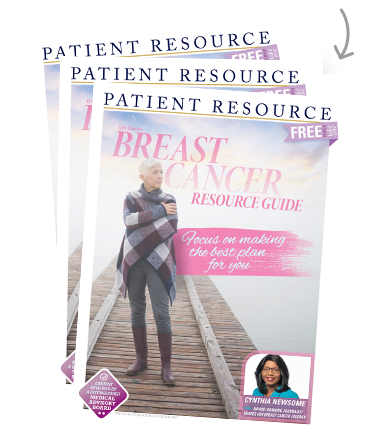Breast Cancer
Survivorship Brings New Challenges and Opportunities
No two breast cancer survivors are alike because every person’s experience with the disease is unique. The term “cancer survivor” means different things to different people, but it commonly refers to anyone who has lived with, through or beyond cancer. Survivorship doesn’t begin when you finish treatment, or when you’re cancer-free. Instead, it begins the moment you’re diagnosed, when you join an estimated 3.5 million women and men across the United States who are also breast cancer survivors.
Your Survivorship Care Plan
At the end of your primary treatment, your oncologist should develop your Survivorship Care Plan, go over it carefully with you and answer any questions you may have. If your doctor doesn’t offer to develop such a plan, ask for it. Or have your patient navigator recommend someone on staff who can help you develop this essential plan for moving forward.
At a minimum, your Survivorship Care Plan should contain these elements:
- Your medical history with dates, including past health issues, how they were treated and the results. Also include your family medical history.
- Your cancer history with dates, including type, subtype and stage of breast cancer, treatments and results, treatment side effects and possible long-term or late effects, and clinical trial information if applicable.
- The names and contact information for every member of your health care team and their roles in your care.
- A proposed Follow-Up Care Plan and appointment schedule, with the name and contact information of the doctor(s) who will provide your care.
Keep your Survivorship Care Plan with your important medical documents. Give a copy to all health professionals you see in the future, including your primary care physician.
Follow-Up Cancer Care
Your follow-up cancer care will consist of regular appointments with your oncologist for the first years, and later this often transitions to your primary care physician. The appointments are routinely scheduled every 3 to 6 months in the beginning, and the visits usually stretch to every 6 to 12 months between years 3 and 5. After 5 years, appointments are annual in most cases. During each visit, tell your doctor about any problems and concerns you’ve had. In between visits, if you notice signs that may point to late effects, a recurrence or a second cancer, let your doctor know immediately.
In addition to physician visits, regular mammograms are generally recommended every 6 to 12 months — depending on your treatment. Bone density scans are also advised for women at high risk for osteoporosis — again, depending on the type of treatment and breast cancer you had.
Some breast cancer survivors’ post-treatment plans may include adjuvant therapies — one or more therapies that are administered after the primary treatment plan is completed. Your oncologist will discuss these options that are designed to increase long-term, cancer-free survival. They may include hormone therapy if your cancer is hormone-receptor positive. Targeted therapy may be recommended, particularly if your tumor is HER2 positive. Chemotherapy or radiation therapy may also be used in certain cases.
Many survivors may choose to participate in clinical trials after their initial treatment plan has concluded. There are ongoing clinical trials across the country, and many are testing new methods to prevent breast cancer recurrence and increase long-term survival.
Be Patient with Yourself
Breast cancer survivors are often surprised to learn that cancer-related issues frequently aren’t resolved with the end of primary treatment. Recovering from cancer – physically, emotionally and mentally – can take a great deal of patience and more time than many survivors and their families expect. Treatment-related side effects such as fatigue, chronic pain and cognitive dysfunction (chemo brain) can last for weeks, months or even years. It’s important to be patient with yourself during this transition as you adjust to the new challenges and opportunities that may accompany survivorship.
You may also experience emotional changes that can range from relief and gratitude to fear and anxiety. Many options and resources are available to help you alleviate and manage these issues, so it’s essential to stay in frequent contact with your health care team post-treatment. Let them know how you’re feeling, and be as specific as possible so they can provide the help you need to feel better.
A central issue for many breast cancer survivors involves their perception that they now lack, or have lost, their desirability and/or sexuality after the loss of one or both breasts. Whether to have breast reconstruction may also be a difficult decision. For many women, having honest conversations with a supportive partner or a close friend may help alleviate any struggles with self-esteem or body image. Professional counseling may also be beneficial for these issues.
Because some things are out of your control, focus on what you can control. Doing so may help you emotionally and improve your sense of well-being. For example, if your doctor approves, try brisk walking, yoga, meditation or tai chi to reduce stress and boost your fitness. If you use tobacco, try to quit. Limit your use of alcohol. Educate yourself about nutritious eating habits, which will benefit your overall health. Participating in a breast cancer support group, either in-person or online, can provide a great source of strength and a sense of community. You may also gain insight into how others have resolved cancer-related issues you may be facing and develop new friendships based on your shared cancer experiences. Consider giving back to the community by volunteering with a local cancer center or cancer advocacy group.



